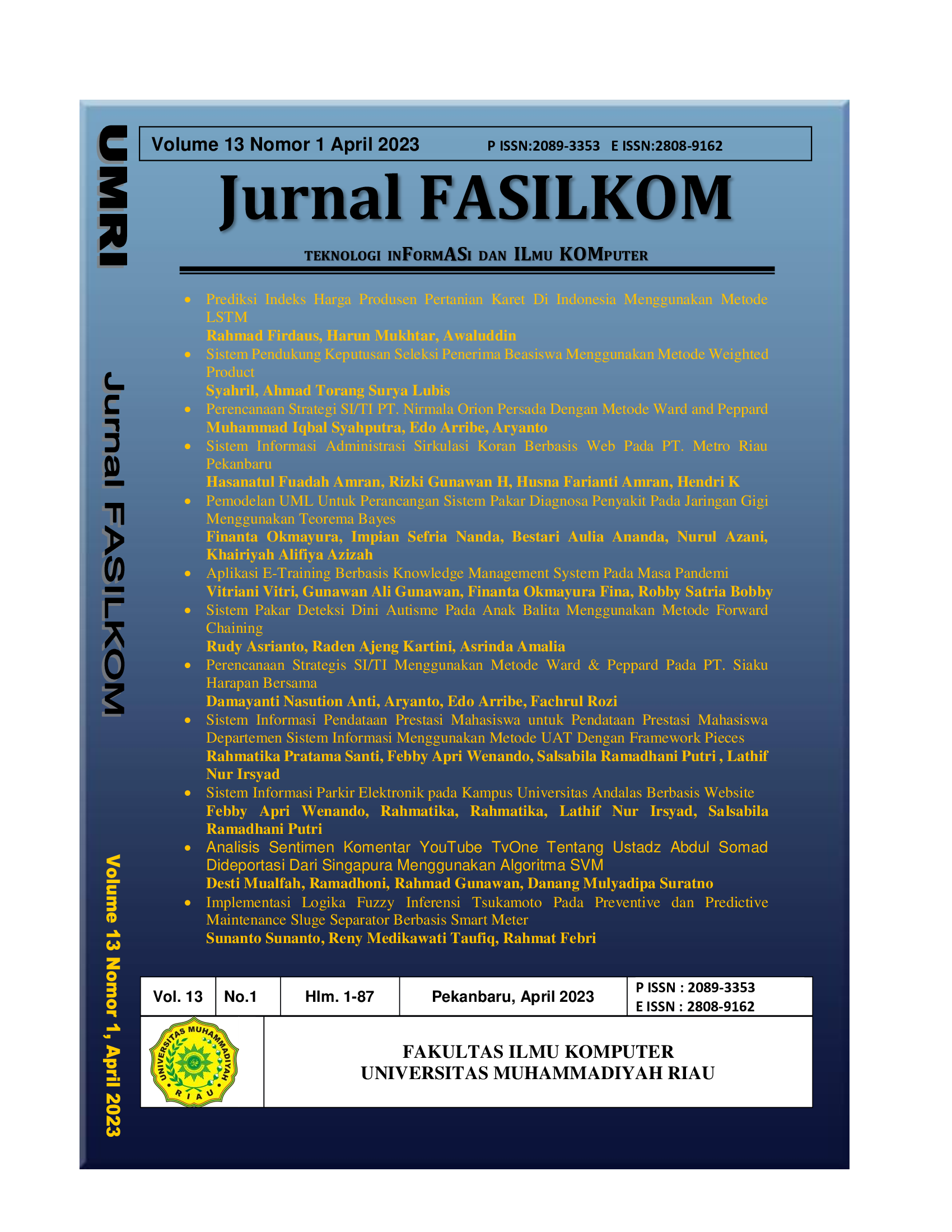Implementasi Logika Fuzzy Inferensi Tsukamoto Pada Preventive dan Predictive Maintenance Sluge Separator Berbasis Smart Meter
Implementasi Logika Fuzzy Inferensi Tsukamoto Pada Preventive dan Predictive Maintenance Sluge Separator Berbasis Smart Meter
Abstract
The clarifier station is also known as a purification station. Its main function is to obtain palm oil in a very pure condition. There are several machines ready to work to refine Crude Palm Oil from palm oil. One of the machines at the refining station is the Sludge Separator which has the function of extracting oil that is still contained in a centrifugal manner where water and NOS with a specific gravity greater than oil will be thrown out and oil will enter the interior. The Sludge Separator method separates oil from water and NOS, namely by rotating (spinning) the bowl that has been installed and released through the nozzle. This rotation is generated from the conveyor motor. To optimize the work of the clarification station, especially on the Sludge Separator machine, a tool and system was created to monitor traffic flow, record the start time of the active Sludge Separator conveyor motor and schedule Preventive and Predictive Maintenance according to the working conditions of the motor, to make the system use the method/algorithm Fuzzy Tsukamoto. And in this research implementation, testing and results will be carried out on a prototype that utilizes the NodeMCU microcontroller (esp32), current and web sensors using hypertext preprocessor
Downloads
References
[2] A. Nasution, M. A. Nasution, M. Rivani, H. Lydiasari, and A. Wulandari, “Kajian Komparasi Kinerja Sludge Separator Dan Dekanter 3 Fasa Pabrik Kelapa Sawit ( PKS ) Comparasion Study of Sludge Separator and 3 Phase Decanter Performance in Palm Oil Mill ( POM ),” vol. 30, no. 1, pp. 1–14, 2022.
[3] M. Widyantoro, A. Munawir, U. Bhayangkara Jakarta Raya, J. Perjuangan, and M. Mulya Bekasi, “Analisis Preventive Maintenance Pada Mesin Stationery Spot Welding,” vol. 7, no. 2, pp. 1–5, 2021.
[4] A. Masnur and M. K. Anam, “RABIT : Jurnal Teknologi dan Sistem Informasi Univrab Volume 4 No . 1 | Januari 2019 : 1-7 ISSN CETAK : 2477-2062 ISSN ONLINE : 2502-891X Implementasi Logika Fuzzy Dengan Inferensi Tsukamoto Pada Deteksi Kegagalan Sistem Transfer Cake Breaker Conveyor ( C,” vol. 4, no. 1, pp. 1–7, 2019.
[5] S. Sunaryo, J. Japri, Y. Yuhelson, and L. Hakim, “Implementasi RCM pada mesin diesel Deutz 20 kVA,” Turbo J. Progr. Stud. Tek. Mesin, vol. 10, no. 1, 2021, doi: 10.24127/trb.v10i1.1451.
[6] A. Kurnia Pratama, E. Zondra, and H. Yuvendius, “Analisis Efisiensi Motor Induksi Tiga Phasa Akibat Perubahan Tegangan,” J. Sain, Energi, Teknol. Ind., vol. 5, no. 1, pp. 35–43, 2020.
[7] R. P. Prasetya, “Implementasi Fuzzy Mamdani Pada Lampu Lalu Lintas Secara Adaptif Untuk Meminimalkan Waktu Tunggu Pengguna Jalan,” J. Mnemon., vol. 3, no. 1, pp. 24–29, 2020, doi: 10.36040/mnemonic.v3i1.2526.
[8] R. Adriman, M. Asfianda, A. A, and Y. Away, “Sistem Embedded Cerdas Menggunakan Logika Fuzzy Untuk Efisiensi Konsumsi Energi Listrik,” J. Ilm. Tek. Elektro Komput. dan Inform., vol. 4, no. 1, p. 58, 2018, doi: 10.26555/jiteki.v4i1.9945.
[9] F. Dristyan, Y. Apridonal, and M. Meri, “Analisis Kepuasan Siswa Terhadap Pelayanan Program Studi Menggunakan Logika Fuzzy (Studi Kasus: STMIK Royal Kisaran),” J. CoSciTech (Computer Sci. Inf. Technol., vol. 3, no. 3, pp. 389–395, 2022, doi: 10.37859/coscitech.v3i3.4271.
[10] W. Buana, “Penerapan Fuzzy Mamdani Untuk Sistem Pendukung Keputusan Pemilihan Telepon Seluler,” Edik Inform., vol. 2, no. 1, pp. 138–143, 2017, doi: 10.22202/ei.2015.v2i1.1455.
[11] A. Noerifanza, “Analisa Kelayakan Modul Esp32 Sebagai Kamera untuk Pengenalan Objek Sehari-hari,” J. Comput. Electron. Telecommun., vol. 3, no. 2, 2022, doi: 10.52435/complete.v3i2.263.
Copyright (c) 2023 Sunanto, Reny Medikawati Taufiq, Rahmat Febri

This work is licensed under a Creative Commons Attribution-ShareAlike 4.0 International License.
Copyright Notice
An author who publishes in the Jurnal FASILKOM (teknologi inFormASi dan ILmu KOMputer) agrees to the following terms:
- Author retains the copyright and grants the journal the right of first publication of the work simultaneously licensed under the Creative Commons Attribution-ShareAlike 4.0 License that allows others to share the work with an acknowledgement of the work's authorship and initial publication in this journal
- Author is able to enter into separate, additional contractual arrangements for the non-exclusive distribution of the journal's published version of the work (e.g., post it to an institutional repository or publish it in a book) with the acknowledgement of its initial publication in this journal.
- Author is permitted and encouraged to post his/her work online (e.g., in institutional repositories or on their website) prior to and during the submission process, as it can lead to productive exchanges, as well as earlier and greater citation of the published work (See The Effect of Open Access).
Read more about the Creative Commons Attribution-ShareAlike 4.0 Licence here: https://creativecommons.org/licenses/by-sa/4.0/.
 Abstract views: 156 ,
Abstract views: 156 ,  pdf downloads: 166
pdf downloads: 166













_(1).png)


